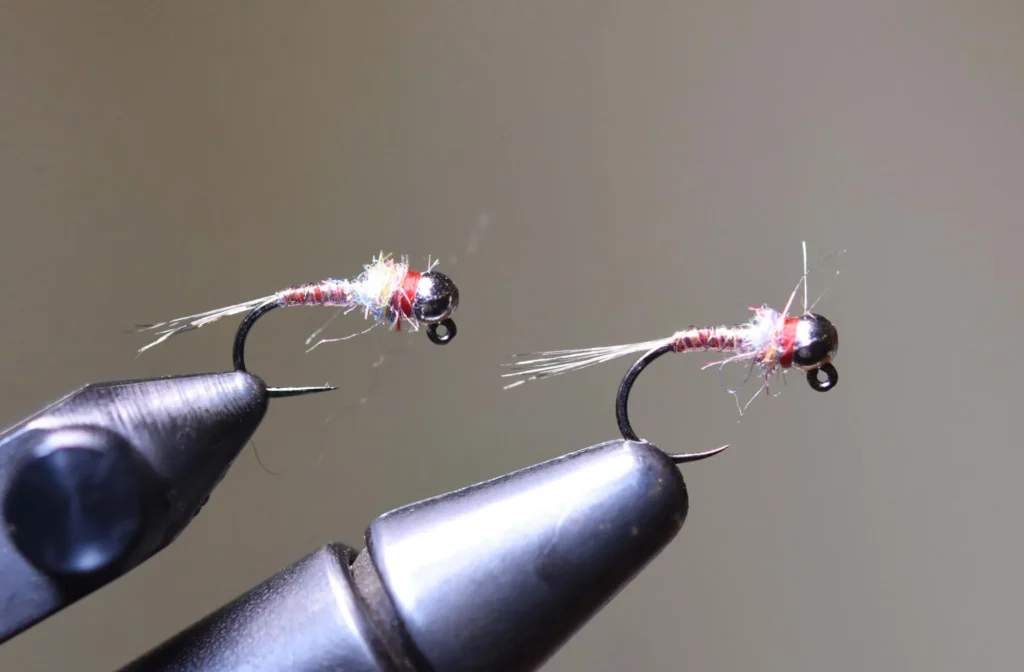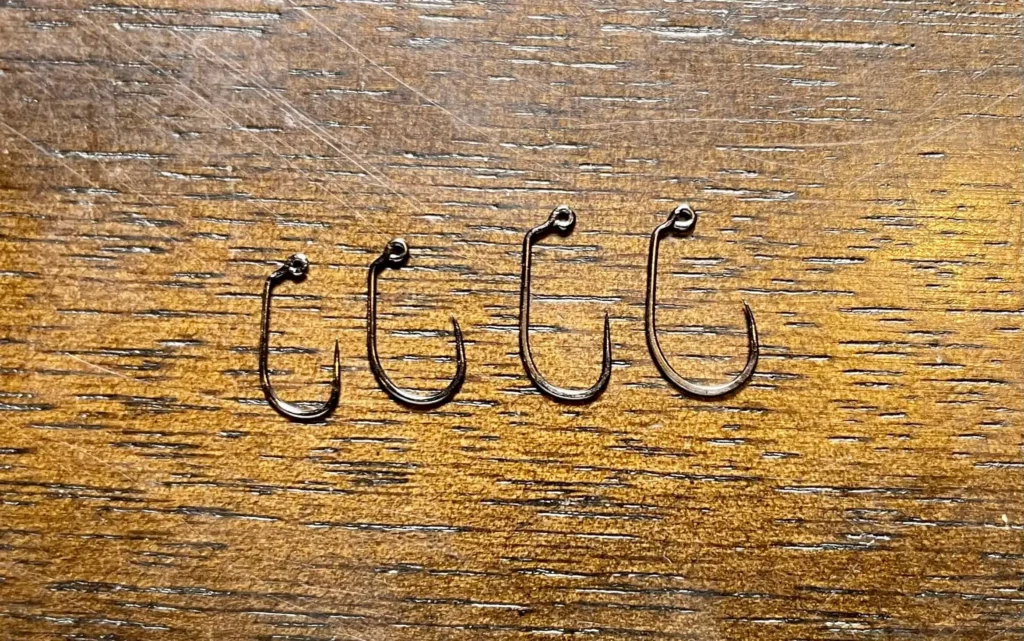Hooking Power: Wide Gap Versus Standard Gap Fly Tying Hooks

Fly tiers today have a vast assortment of materials available to them, including hooks of almost every style and design imaginable. One of those variations is the wide gap hook, sometimes called a wide “gape” hook. The fact that it’s called wide means that there must be a standard gap. But what exactly is a standard gap, and what is a wide gap, and how do you know which one to use next time you sit down at your fly tying vise?
There are a few very important things to consider before selecting a standard gap or wide gap hook for your next pattern. Typically, it’s assumed that wide gap hooks will hold fish better, which we’ll discuss later in this post, but more than that, the hook you choose to tie on will directly impact the final appearance of the pattern and ultimately how well it fishes. So let’s look at what hook gap is and when each type (standard or wide) performs best in certain situations.
Understanding Gap and Why it Matters
By definition, hook gap refers to the distance between the shank and the point of the hook. This distance directly effects how well you hook a fish, which is why small hooks (and they’re equally small gaps) can result in so many misses.
A “standard” hook has a shank approximately twice as long as the width of the hook gap. As the shank is lengthened or shortened, the hook gap decreases or increases, respectively, in relation to what is considered normal. Hence, we see hook shanks that are 2XL, 3XL, 4XL, and so and know that those will have shanks much longer than standard hooks. On the other end of the spectrum, we have hook shanks that are 2XS, 3XS, 4XS, and so on and know that those will have shanks much shorter than standard hooks.
Ironically, “standard” is a variable term for many hook manufacturers. There are seemingly countless brands of hooks on the market today, ranging from relatively inexpensive to high-end shanks, and most of them produce their own versions of various models and sizes. However, although they may look similar, there can be drastic differences in sizing between each brand – a size 12 of one brand, for instance, may be much larger than a comparable size of another brand.
Also, for reasons unknown to me, most companies that make a wide gap hook often manufacture that model with a 1X short or shorter shank. The result is an exaggerated wide gap. It would help us fly tiers and anglers considerably if the industry would join together and agree on some sort of universally accepted standard. As it is right now, it’s the Wild West out there as far as hook sizing goes!
All of this is to say that to truly understand hook gap, you need apples to apples and brand to brand comparisons. No two brands have identical hook shank lengths, bends, and gaps, which is why I highly recommend that once you find a brand that you enjoy tying with, stick to that brand for most of your patterns. Doing this will provide more consistency in your fly tying in terms of sizing and hook gaps, if that is indeed important to you – and it should be because the hook you choose to tie on will absolutely impact the final appearance of those patterns. Incidentally, I have no evidence that suggests trout or other fish are affected by the larger profile of a wide gap hook.
More than that, though, brand loyalty will also help you repeat success with certain patterns. As long as you’re using the same brand of hooks every time, then you’ll know exactly how big a size 14 or 16 of that brand will turn out, which will inform your fly selection while on the water and make you a more successful fly fisherman.

When to Use a Wide Gap Hook
Hook gap is something that most fly fishermen don’t even consider. I suspect this is because many anglers who buy their flies rather than tie their own probably don’t realize the options available or the benefits of a wide gap hook on many of the patterns they use. Wide gap hooks serve an important role in the angler’s arsenal. I’ve found them especially helpful in two particular situations: when I’m tying bulky flies and when I’m tying very small flies. Both of these directly impact my catch rates on the river.
Bulky flies: The more material you pile onto a shank, the more the hook gap starts to shrink, and you lose hooking power. Reducing the amount of gap between the shank and the hook point reduces that fly’s ability to hook and hold fish.
For species such as bass, which have very hard mouths that are difficult to penetrate on the hook set, this smaller gap will produce more misses. The gap won’t be big enough to get past that hard outer lip. I see this a lot with poppers that are tied on standard gap hooks, and for me it was a frustrating part of learning to fish for bass. I wondered why I missed so many large bass in local ponds yet never had a problem landing smaller ones. Once I started purchasing and tying my bass bugs on wide gap hooks, that problem diminished, and I landed more bigger fish simply because I now had the right flies tied on the right hooks.
The same is true of egg patterns and foam-bodied flies. Many materials used to tie egg patterns and foam flies can get bulky and obstruct the hook gap if you’re not careful. This is why most hooks designed for egg patterns are listed as 3XS, 4XS, and 5XS. The hook shank may be 3-5X shorter, but the gap is still the same as the gap of a standard length hook, so a 1X short size 16, for instance, might have the same hook gap as a size 14.
Small flies: Wide gap hooks are also great for small patterns when every little bit of hooking power counts. In my experience, I miss more trout on size 20s than I do on 18s – including dry flies, nymphs, and even wet flies – and to consistently hook more fish on these smaller presentations often means adapting to a slower hook set. (Here’s an article I wrote a while back about how to have more success fishing with small flies.) But more than that, I’ve started tying my small patterns on wide gap hooks and my miss rates have gone down.
When tying very small flies (size 20s and smaller), every little bit of extra hook gap will produce more hook ups and help you land more fish. If you’re fishing heavy, fast water, this is of particular importance because you’re not just fighting the fish but also the current.
Small flies that require multiple materials can be really challenging to tie because they tend to get bulky. This is why we often hear about “keeping it sparse” on small patterns. We’re not just talking about keeping a pattern lean but also making sure to not block the hook gap more than necessary. For small flies that tend to get bulky, a wide gap hook is an ideal choice.
When to Use Standard Gap
Standard gap hook will work on most occasions for most patterns. So much of how a hook holds depends on how the fish actually eats the fly, and there are no guarantees when it comes to that!
There are also times when a standard gap hook, which generally has a smaller profile, might be preferred, simply based on aesthetic reasons; they’re just visually more appealing and balanced looking. In my humble opinion.
Another time when I consider standard gap over wide gap hooks is when the hook model I want doesn’t come in a particular gauge of wire. An example would be when tying flies for heavy, powerful fish like steelhead. I like hooks that are a minimum 1X strong, with 2X strong being preferred. A wide gap hook on standard gauge wire has a better chance of bending or breaking than a standard gap hook on the same gauge wire because they can be torqued a little more while playing the fish. They’re basically carrying more weight on a shorter shank and therefore have a greater chance of bending or breaking.

Are You Finding This Article Helpful?
Stay up to date with the Dark Skies Fly Fishing monthly newsletter for free and receive the latest posts in fly fishing news, tricks, tips, and techniques, stream reports, as well as updates on new flies added to the Online Store and exclusive discounts!
Sign Up NowDo Wide Gaps Hook Better?
Based on personal experience, the plain and simple answer is yes, wide gap hooks tend to hook fish better. The reasons are purely mathematical. For instance, a size 18 wide gap hook has the same shank length as a standard size 18 hook, but it has the gap of a size 16. A size 18 with a 2X wide gap has approximately the same hooking power as a size 14.
The following two charts offer a fine comparison of two very similar 60 degree jig-style hooks. These models, sold through Wholesale Fly Company, are solid hooks that I’ve used quite a bit for my personal fly tying, mainly because their sizing is very consistent, even from one model to the next. I’ve found that these hooks have very similar dimensions to “most” other brands on the market, too, which makes them a good source for reference.
Anyway, these charts hopefully demonstrate the shank and gap differences between hooks considered standard gap and wide gap. Oddly enough, you’ll find that most companies that offer wide gap hooks make those hooks with a 1X short (or shorter) shank, which is also the case with the hook models listed in the charts.
Benefits of a Wide Gap Hook
As we’ve already discussed, hooking power is a major benefit of wide gap hooks. In smaller sizes, this is a huge upside. Also, when tying larger, bulkier flies, a wider hook gap is extremely beneficial. But the question you might ask is…why not just use a size larger hook?
The major benefit of a wide gap hook, in my opinion, is that it allows you to control the profile of your fly while increasing its hooking potential. When tying effective patterns, proportion is everything. How well-proportioned the fly is will often determine its effectiveness. Like artists, when tying flies, we often adapt to the size of our “canvas,” and so a longer shanked hook will produce a longer bodied pattern.
Wide gap hooks are my preferred choices for tying smaller flies. If I’m tying on a size 18 wide gap hook, I know my pattern will maintain the small profile that I’d expect of a hook that size, but it will have the hooking power of a larger size 16. Ultimately, that difference in hook gap can make a huge impact on whether or not I land the fish.
Looking to take your fishing to the next level?
Book a day on the water where we can show you how to read the water, make better presentations, catch more fish, and enjoy time spent outdoors more than ever before.
Book Now!
